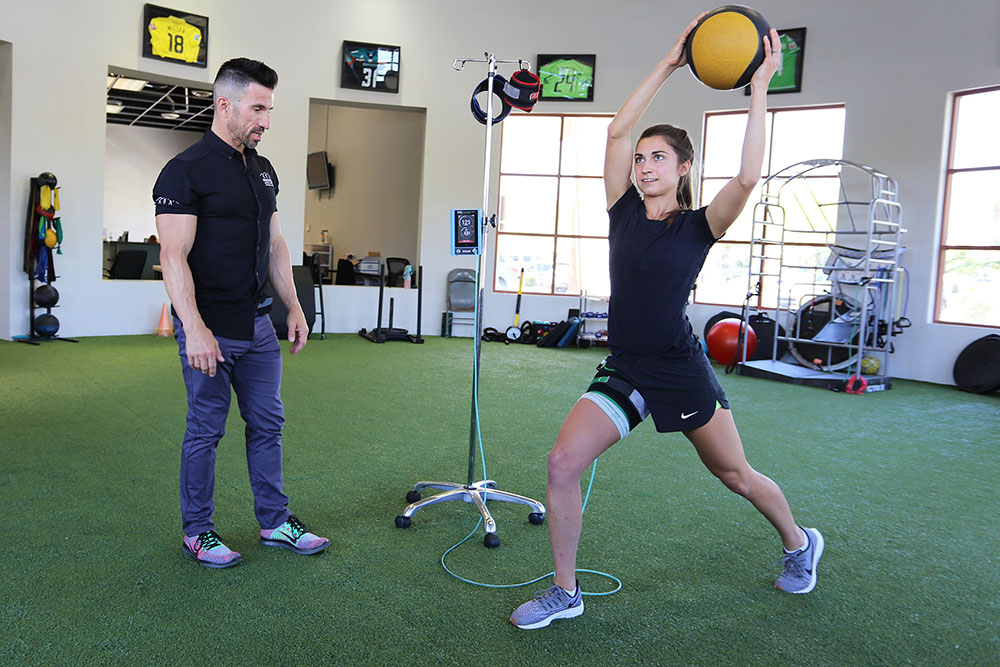What is protein and why is it so important? We often get this question at our physical therapy clinics.
Protein is one of the three primary macronutrients that our body utilizes to create energy. Its siblings are carbohydrates and fats. Together, protein, carbohydrates, and fats make up the holy trinity of nutrition. Protein gets so much of the spotlight, particularly in the fitness world, because it is the most essential building block for adding muscle to your body.
Protein is the product of thousands of smaller structures called amino acids. Amino acids are organic compounds made up of mostly hydrogen, carbon, oxygen, and nitrogen. These amino acids are compounded together in groups and make up protein.
When amino acids and proteins from external sources (animals, plants, powders, bars, etc.) are absorbed by the body, they can be used for energy, to assist in laying down new muscle mass, and repairing damaged tissue. This is why so many fitness personalities and athletes get sponsored and stand behind protein brands. It is a very important tool in their physical development.
So how do you figure out what protein powder to buy? The major factors we look for when examining protein powders are:
- Type
- Quality
- Taste
- Price
- Type
There is a whole array of protein powder types out there and a new one seems to pop up every day. There are plenty of plant-based proteins out there (pea, hemp, soy, etc.), and they are great options for those that choose to not consume animal products. But, in this article, we will focus on the “big dogs” of the industry: whey and casein.
Whey Protein
Whey protein can be separated into 2 categories: concentrate and isolate.
- Whey concentrate is the most common form of whey protein and is in the majority of products we see on the shelves. Whey concentrate is a byproduct of processing dairy into cheese, along with casein (we will talk about that later).
Whey concentrate is described as the most biologically-efficient protein for the human body to absorb. After it is separated from the cheese, it is processed down and filtered into a powder. Concentrate tends to be easier to mix with liquids and have smoother texture/ taste in protein shakes when compared to isolate.
However, there are some downsides to using whey concentrate. This type of protein powder usually contains more fat and sugar than whey isolate, and if you are lactose intolerance you can have some stomach irritation with consumption.
- Whey Isolatestarts out as whey concentrate but is then filtered and processed even further. It is what is left over after almost all the carbs and fats have been removed from the protein molecules. During this process they also eliminate the lactose from the powder, making it consumable for those with lactose intolerances. The additional processing results in a purer protein source: 90% protein compared to the 80% protein in whey concentrate.
The downsides for isolate are: it is more expensive than concentrate and, unless more additives are in the powder, it will be slightly harder to mix and have a less desirable consistency compared to the concentrate.
Casein protein is the commonly forgotten stepbrother of whey protein. It is the other byproduct of producing cheese (other than water). Casein is treated the same as whey in that it is processed and filtered down to a point where it is approximately 80% protein.
The biggest difference between casein protein and its siblings is the rate at which it is absorbed by the body. Compared to whey, casein protein takes much longer to be digested by the body. Casein is still well utilized by the body, but the structure of the proteins take more work to break down, thus a slower digestive period.
- Quality
To identify the quality of your protein, let’s look at how we find the ratio of protein to filler in the protein powder you find on the shelves at your local supplement shop or grocery store. A simple equation is:
(grams of protein per serving/ total grams of contents per serving) X 100
= percentage of protein in a serving
The equation will give you the percentage of protein in each scoop. The higher the percentage, the higher the quality is and the fewer fillers are present in this supplement.
Examples:
Protein A: 47.2g serving size, 22g protein per serving = 47%
Protein B: 31g serving size, 24g protein per serving = 77%
At first glance, these proteins look almost identical in their value, but when diving into it much deeper, we find that Protein B has 30% more protein and less filler that Protein A! That is a significant amount. I will admit that Protein A probably tastes a lot better, but you’re spending your money on stuff that makes up that taste rather than the protein that is helping you achieve your goals.
Rule of thumb:Look for proteins > 50% protein/serving. This will give you the best bang for your buck and usually translates into more servings per container.
- Taste
There is not much information or insight to share here. Find what you like and what you will be able to consume consistently. If you are completely new to protein powder, try buying the smallest containers possible, or going in and buying sample variety packs. This will let you find what you enjoy and not leave you stuck with a giant tub of powder you don’t like.
- Price
When we go out shopping we always have to look at the price and determine the best value for our money. Protein is no different. Instead of focusing on the overall cost or the size of the container, we need to look at the cost per servings. Two tubs of protein may look almost identical in their size, shape, and weight but have drastically different value when you break it down.
Example
Protein A: $19.99, 2 lbs. total weight, 24g of protein per serving, 20 servings
Protein B: $22.99, 2 lbs. total weight, 24g of protein per serving, 28 servings
At first glance, the two options look the same and have the same weight and protein contents. Of course, we are going to buy the cheaper of the two, right? Not quite. If you do the math (price/servings) you find that Protein B will save you $0.18 per serving. If you are taking two scoops of protein every day, this means that you will save approx. $130 every year, aka a new pair of running shoes.
Bottom line: when shopping for a new supplement or fitness aid, it is important to be informed, read the labels, and buy the best option for your money.
If you have further questions about nutrition and supplementation for your fitness goals, talk with your FAST trainer or Foothills Sports Medicine physical therapist. You can even request an appointment online at one of our physical therapy clinics. We are dedicated to helping you live a long, happy, and healthy life.




